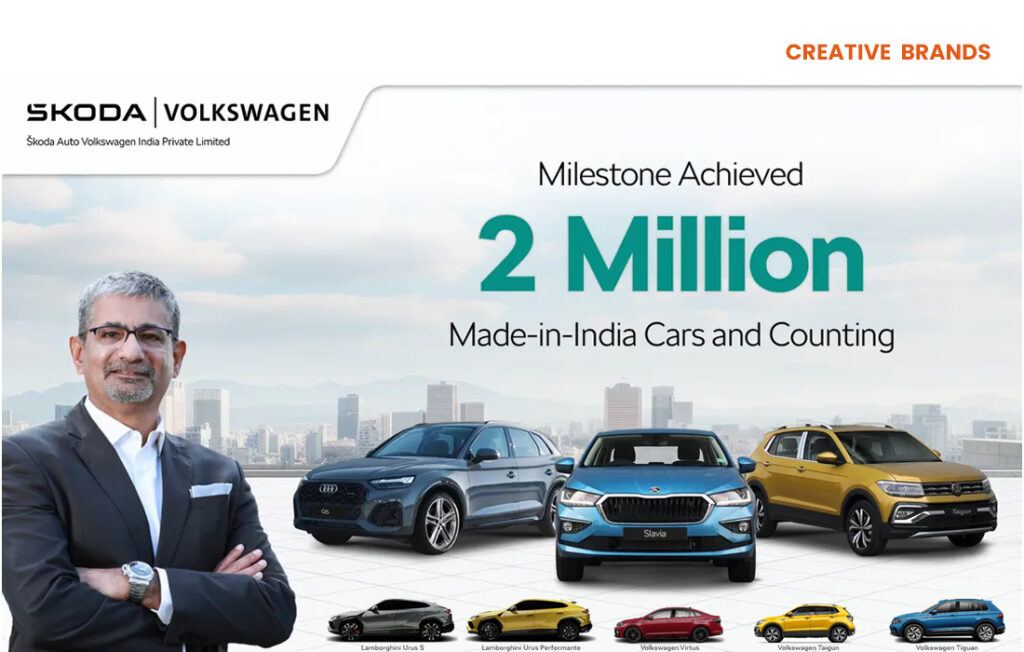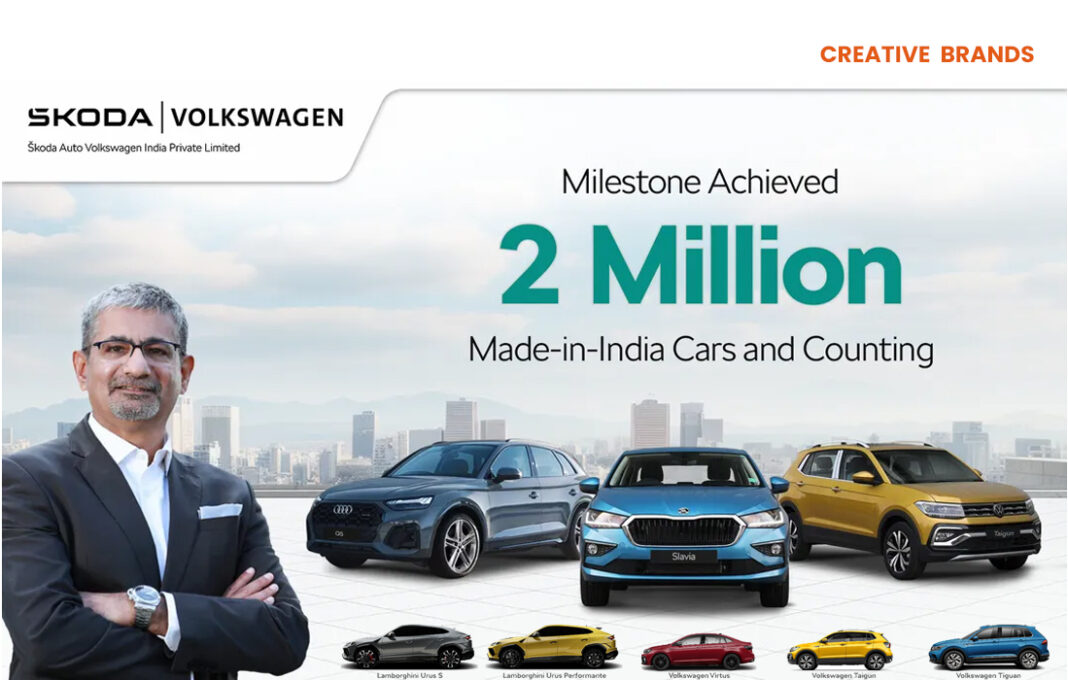Škoda Auto Volkswagen India has achieved a major milestone by producing its 2 millionth vehicle in the country, capping 25 years of local manufacturing. The achievement follows the Group’s strongest commercial month ever and includes over 500,000 cars built on the India-developed MQB-A0-IN platform within just 3.5 years.

Škoda Auto Volkswagen India Private Limited (SAVWIPL) has marked a defining milestone in its journey, rolling out its 2 millionth vehicle from its production line in India. The achievement not only celebrates the company’s 25-year legacy in the country but also reinforces India’s position as a strategic manufacturing hub within the global Volkswagen Group. For an organisation that entered the Indian market during a period of slow adoption for global automotive brands, the 2-million-unit mark represents a culmination of steady growth, local engineering capability and consumer trust built over a quarter of a century.
The landmark comes on the heels of the Group’s strongest-ever commercial performance in India, with October 2025 recorded as its most successful month since its formation. These two milestones, closely aligned, reflect the growing momentum of Škoda and Volkswagen passenger vehicles in India — a market that has transformed dramatically over the last decade. What was once primarily a competition of fuel efficiency and mass affordability has now evolved into a battleground of sophisticated design, safety features, technology-led mobility and premium consumer expectations. SAVWIPL has methodically positioned itself as a key contender in this evolution.
At the heart of the company’s recent growth is the MQB-A0-IN platform, a modular platform developed specifically for India by local engineering teams to suit the preferences, safety benchmarks and challenging road conditions unique to the domestic market. More than 500,000 vehicles from the 2 million production milestone are based on this platform — a clear indicator of its acceptance among both customers and the manufacturing ecosystem. The platform powers the Škoda Kushaq, Slavia and Kylaq, as well as the Volkswagen Taigun and Virtus, forming the backbone of the Group’s India 2.0 strategy.
The speed of the most recent surge tells its own story. While the first 1.5 million units took more than two decades to produce, the last 500,000 rolled out in just 3.5 years. That acceleration is a direct reflection of rising demand for the Group’s India-built products, both domestically and globally. It also underscores the success of a strategic shift that aimed to deepen localisation, reduce import dependence, improve cost structures and bring the brands closer to the needs of Indian consumers. For the company, manufacturing in India is no longer a production strategy — it is a product strategy.
The milestone also highlights SAVWIPL’s investment in the development of automotive engineering talent in India. The MQB-A0-IN platform was not merely adapted locally; it was conceptualised, executed and validated by Indian engineers who built solutions that meet both domestic and global regulatory standards. That includes the upgraded requirements for emissions, pedestrian safety and crash safety — areas in which India has significantly raised the bar in recent years. The platform’s flexibility enables the Group to design multiple global models for varied markets from the same local base, helping reduce development time and strengthen export viability.
Although production numbers traditionally reflect manufacturing growth, they also mirror consumer sentiment — and SAVWIPL’s milestone shows that Indian customers are increasingly gravitating toward safer, premium, feature-rich cars from global brands. Demand for mid-size SUVs and sedans has steadily risen in the urban middle-income and upper-middle-income segments, and Škoda and Volkswagen have played early roles in shaping this shift. Products like the Taigun, Kushaq and Slavia have delivered strong traction among buyers seeking a combination of German engineering, modern design and aspirational positioning without the price barrier once associated with imported models.
It is notable too that the milestone arrives at a moment when India is evolving into one of the world’s most promising automotive markets — not only through domestic sales but also as an export hub. SAVWIPL has been ramping up exports across Latin America, Africa, Southeast Asia and the Middle East, where Indian-built models have been received with enthusiasm. Every one of the 2 million vehicles produced is part of a broader narrative of India-integrated global manufacturing strategy, in which the country’s facilities are expected to serve increasingly diverse markets in the years ahead.
The Group’s 25 years in India also tell a story of resilience. The brand entered the country when global passenger vehicle penetration was far more modest and has navigated multiple shifts in fuel policies, consumer behaviour, competition intensity and market preferences. The Group has weathered downturns, recalibrated strategy when needed and retained long-term commitment, even during periods when India’s automotive market posed significant uncertainty. The 2 million milestone stands not only as a testament to operational success but also to the company’s decision to stay invested for the long run.
Looking ahead, the Group is expected to continue building on the momentum established over the past four years. The MQB-A0-IN platform will remain integral, with new models set to emerge, including expanded SUV portfolios and updates to existing top performers. Electrification will take centre stage as India’s EV transition accelerates, and industry observers believe the platforms and supply chain localisations already in progress will provide a strong runway to build electric models competitively. Whether these EVs will emerge from adaptation of existing modular global platforms or entirely new India-developed structures, SAVWIPL’s trajectory suggests that localisation will be a foundational component.
Another area of focus will likely be capacity expansion and vendor ecosystem strengthening. Higher domestic demand, combined with rising global export requirements, is expected to place additional pressure on production output. The company has already shown a pattern of increasing supplier localisation and encouraging tier-2 and tier-3 partner development — a move that contributes to cost optimisation and technological self-reliance while stimulating local industrial growth.
Ultimately, the milestone represents more than a number rolled off a production line. It stands as a symbol of evolution — of how the Indian automobile industry, once dependent on global technology imports, is now contributing homegrown engineering innovation to the world. It demonstrates what is possible when global automotive expertise and Indian technical capability converge. And it points to a future where cars engineered in India are not just made for India but for markets across the world.
As Škoda Auto Volkswagen India moves into its next chapter, the 2 million mark serves as both a reward for past commitment and a launch pad for the ambitions ahead. The journey from market entry to milestone maker has taken 25 years, but the pace of the most recent progress — half a million vehicles in 3.5 years — suggests that the next million may arrive much sooner than anyone once expected.







